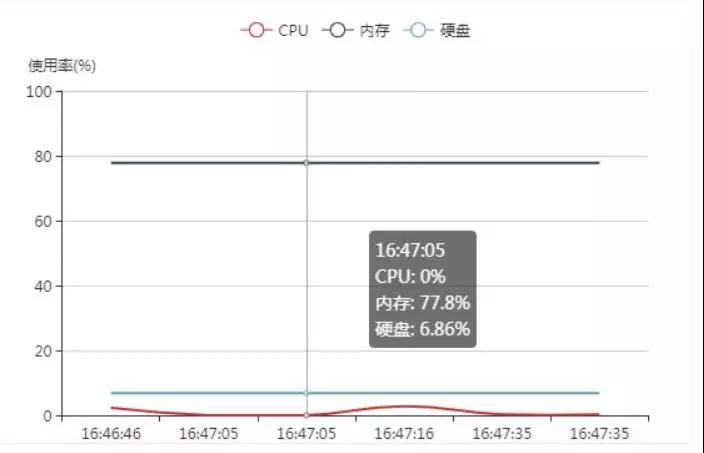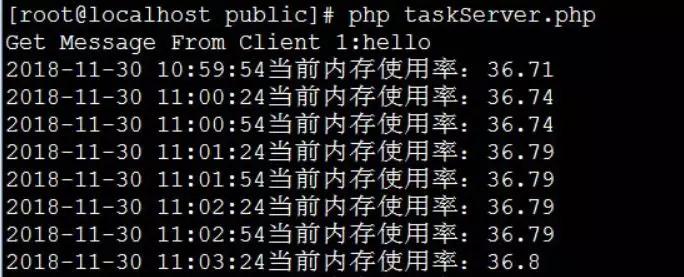Swoole实现毫秒级定时任务
项目开发中,如果有定时任务的业务要求,我们会使用linux的crontab来解决,但是它的最小粒度是分钟级别,如果要求粒度是秒级别的,甚至毫秒级别的,crontab就无法满足,值得庆幸的是swoole提供的强大的毫秒定时器。
应用场景举例
我们可能会遇到这样的场景:
场景一:每隔30秒获取一次本机内存使用率
场景二:2分钟后执行报表发送任务
场景三:每天凌晨2点钟定时请求第三方接口,如果接口有数据返回则停止任务,如果接口由于某种原因没有响应或者没有数据返回则5分钟后继续尝试请求该接口,尝试5次后仍然失败则停止该任务
以上的三个场景我们都可以归纳为定时任务的范畴。
Swoole毫秒定时器
Swoole提供了异步毫秒定时器函数:
swoole_timer_tick(int $msec, callable $callback):设置一个间隔时钟定时器,每隔$msec毫秒执行一次$callback,类似于javascript中的setInterval()。
swoole_timer_after(int $after_time_ms, mixed $callback_function):在指定的时间$after_time_ms后执行$callback_function,类似于javascript的setTimeout()。
swoole_timer_clear(int $timer_id):删除指定id的定时器,类似于javascript的clearInterval()。
解决方案
对于场景一,经常用在系统检测统计方面,实时性要求比较高,但又能控制好频率,多用于后台服务器性能监控,可以生成可视化图表。可以是30秒获取一次内存使用率,也可以是10秒,而crontab最小粒度只能设置为1分钟。
swoole_timer_tick(30000, function($timer) use ($task_id) { // 启用定时器,每30秒执行一次
$memPercent = $this->getMemoryUsage(); //计算内存使用率
echo date('Y-m-d H:i:s') . '当前内存使用率:'.$memPercent."\n";
});
对于场景二,直接定义xx时间后执行某项任务的话,貌似crontab比较困难,而使用swoole的swoole_timer_after可以实现:
swoole_timer_after(120000, function() use ($str) { //2分钟后执行
$this->sendReport(); //发送报表
echo "send report, $str\n";
});
对于场景三,用来作尝试请求,请求失败后继续,如果成功则停止请求。用crontab也能解决,但是比较傻,比如设置每隔5分钟请求一次,不管成功会失败都会去执行一次。而用swoole定时器则智能多了。
swoole_timer_tick(5*60*1000, function($timer) use ($url) { // 启用定时器,每5分钟执行一次
$rs = $this->postUrl($url);
if ($rs) {
//业务代码...
swoole_timer_clear($timer); // 停止定时器
echo date('Y-m-d H:i:s'). "请求接口任务执行成功\n";
} else {
echo date('Y-m-d H:i:s'). "请求接口失败,5分钟后再次尝试\n";
}
});
示例代码
新建文件\src\App\Task.php:
<?php
namespace Helloweba\Swoole;
use swoole_server;
/**
* 任务调度
*/
class Task
{
protected $serv;
protected $host = '127.0.0.1';
protected $port = 9506;
// 进程名称
protected $taskName = 'swooleTask';
// PID路径
protected $pidPath = '/run/swooletask.pid';
// 设置运行时参数
protected $options = [
'worker_num' => 4, //worker进程数,一般设置为CPU数的1-4倍
'daemonize' => true, //启用守护进程
'log_file' => '/data/log/swoole-task.log', //指定swoole错误日志文件
'log_level' => 0, //日志级别 范围是0-5,0-DEBUG,1-TRACE,2-INFO,3-NOTICE,4-WARNING,5-ERROR
'dispatch_mode' => 1, //数据包分发策略,1-轮询模式
'task_worker_num' => 4, //task进程的数量
'task_ipc_mode' => 3, //使用消息队列通信,并设置为争抢模式
];
public function __construct($options = [])
{
date_default_timezone_set('PRC');
// 构建Server对象,监听127.0.0.1:9506端口
$this->serv = new swoole_server($this->host, $this->port);
if (!empty($options)) {
$this->options = array_merge($this->options, $options);
}
$this->serv->set($this->options);
// 注册事件
$this->serv->on('Start', [$this, 'onStart']);
$this->serv->on('Connect', [$this, 'onConnect']);
$this->serv->on('Receive', [$this, 'onReceive']);
$this->serv->on('Task', [$this, 'onTask']);
$this->serv->on('Finish', [$this, 'onFinish']);
$this->serv->on('Close', [$this, 'onClose']);
}
public function start()
{
// Run worker
$this->serv->start();
}
public function onStart($serv)
{
// 设置进程名
cli_set_process_title($this->taskName);
//记录进程id,脚本实现自动重启
$pid = "{$serv->master_pid}\n{$serv->manager_pid}";
file_put_contents($this->pidPath, $pid);
}
//监听连接进入事件
public function onConnect($serv, $fd, $from_id)
{
$serv->send( $fd, "Hello {$fd}!" );
}
// 监听数据接收事件
public function onReceive(swoole_server $serv, $fd, $from_id, $data)
{
echo "Get Message From Client {$fd}:{$data}\n";
//$this->writeLog('接收客户端参数:'.$fd .'-'.$data);
$res['result'] = 'success';
$serv->send($fd, json_encode($res)); // 同步返回消息给客户端
$serv->task($data); // 执行异步任务
}
/**
* @param $serv swoole_server swoole_server对象
* @param $task_id int 任务id
* @param $from_id int 投递任务的worker_id
* @param $data string 投递的数据
*/
public function onTask(swoole_server $serv, $task_id, $from_id, $data)
{
swoole_timer_tick(30000, function($timer) use ($task_id) { // 启用定时器,每30秒执行一次
$memPercent = $this->getMemoryUsage();
echo date('Y-m-d H:i:s') . '当前内存使用率:'.$memPercent."\n";
});
}
/**
* @param $serv swoole_server swoole_server对象
* @param $task_id int 任务id
* @param $data string 任务返回的数据
*/
public function onFinish(swoole_server $serv, $task_id, $data)
{
//
}
// 监听连接关闭事件
public function onClose($serv, $fd, $from_id) {
echo "Client {$fd} close connection\n";
}
public function stop()
{
$this->serv->stop();
}
private function getMemoryUsage()
{
// MEMORY
if (false === ($str = @file("/proc/meminfo"))) return false;
$str = implode("", $str);
preg_match_all("/MemTotal\s{0,}\:+\s{0,}([\d\.]+).+?MemFree\s{0,}\:+\s{0,}([\d\.]+).+?Cached\s{0,}\:+\s{0,}([\d\.]+).+?SwapTotal\s{0,}\:+\s{0,}([\d\.]+).+?SwapFree\s{0,}\:+\s{0,}([\d\.]+)/s", $str, $buf);
//preg_match_all("/Buffers\s{0,}\:+\s{0,}([\d\.]+)/s", $str, $buffers);
$memTotal = round($buf[1][0]/1024, 2);
$memFree = round($buf[2][0]/1024, 2);
$memUsed = $memTotal - $memFree;
$memPercent = (floatval($memTotal)!=0) ? round($memUsed/$memTotal*100,2):0;
return $memPercent;
}
}
我们以场景一为例,在onTask启用定时任务,每隔30秒计算一次内存使用率。实际应用中可以把计算好的内存按时间写入数据库等存储中,然后可以根据前端需求用来渲染成统计图表,如:

接着服务端代码 public\taskServer.php :
<?php
require dirname(__DIR__) . '/vendor/autoload.php';
use Helloweba\Swoole\Task;
$opt = [
'daemonize' => false
];
$ser = new Task($opt);
$ser->start();
客户端代码 public\taskClient.php :
<?php
class Client
{
private $client;
public function __construct() {
$this->client = new swoole_client(SWOOLE_SOCK_TCP);
}
public function connect() {
if( !$this->client->connect("127.0.0.1", 9506 , 1) ) {
echo "Error: {$this->client->errMsg}[{$this->client->errCode}]\n";
}
fwrite(STDOUT, "请输入消息 Please input msg:");
$msg = trim(fgets(STDIN));
$this->client->send( $msg );
$message = $this->client->recv();
echo "Get Message From Server:{$message}\n";
}
}
$client = new Client();
$client->connect();
验证效果
1.启动服务端:
php taskServer.php
2.客户端输入:
另开命令行窗口,执行
[root@localhost public]# php taskClient.php
请输入消息 Please input msg:hello
Get Message From Server:{"result":"success"}
[root@localhost public]#
3.服务端返回:

如果返回上图中的结果,则定时任务正常运行,我们会发现每隔30秒会输出一条信息。
Swoole实现毫秒级定时任务的更多相关文章
- php Swoole实现毫秒级定时任务
项目开发中,如果有定时任务的业务要求,我们会使用linux的crontab来解决,但是它的最小粒度是分钟级别,如果要求粒度是秒级别的,甚至毫秒级别的,crontab就无法满足,值得庆幸的是swoole ...
- Swoft 2.0.5 更新,新增高效秒级定时任务、异常管理组件
什么是 Swoft ? Swoft 是一款基于 Swoole 扩展实现的 PHP 微服务协程框架.Swoft 能像 Go 一样,内置协程网络服务器及常用的协程客户端且常驻内存,不依赖传统的 PHP-F ...
- Linux下得到毫秒级时间--C语言实现(转-度娘818)
Linux下得到毫秒级时间--C语言实现 原文链接: http://www.cnblogs.com/nwf5d/archive/2011/06/03/2071247.html #ifdef HAVE_ ...
- 51单片机C51毫秒级(ms)精确延时
如下程序能实现ms毫秒级的比较精确的延时 void Delayms(unsigned int n) { unsigned int i,j; ;j--) ;i>;i--); } 用keil可以看出 ...
- VC中如何获取当前时间(精度达到毫秒级)
标 题: VC中如何获取当前时间(精度达到毫秒级)作 者: 0xFFFFCCCC时 间: 2013-06-24链 接: http://www.cnblogs.com/Y4ng/p/Millisecon ...
- GetSystemTime API可以得到毫秒级时间
用Now返回的日期格式中年只有2位,即2000年显示为00, 这似乎不太令人满意. 此外Now和Time都只能获得精确到秒的时间,为了得到更精确的毫秒级时间,可以使用API函数GetSystemTim ...
- Python获取秒级时间戳与毫秒级时间戳
获取秒级时间戳与毫秒级时间戳 import time import datetime t = time.time() print (t) #原始时间数据 print (int(t)) #秒级时间戳 p ...
- 使用bitset实现毫秒级查询
前言 因为业务要求api的一次请求响应时间在10ms以内,所以传统的数据库查询操作直接被排除(网络io和磁盘io).通过调研,最终使用了bieset,目前已经正常运行了很久 *** bitset介绍 ...
- C++计时器:毫秒级和微秒级
1.毫秒级 使用GetTickCount()获取系统启动所经过的毫秒数 #include<iostream> using namespace std; int main(){ DWORD ...
随机推荐
- make clean 和 make distclean区别-(转自秋水Leo)
make clean仅仅是清除之前编译的可执行文件及配置文件. 而make distclean要清除所有生成的文件. Makefile 在符合GNU Makefiel惯例的Makefile中,包含了一 ...
- JAVA基础语法-day01
JAVA基础语法 1.注释 单行注释--// 多行注释--/* */ 文档注释--/** */ 2.标识符 只能大小写字母,$,下划线开头,其它不行. 3.数据类型 基本数据类型--整数,浮点,字符, ...
- mysql数据库-运维合集
目录 RDBMS 术语 整删改查操作 库操作 表操作 账号与授权 匹配符(条件查询) MySQL三大类数据类型 函数 其他操作 查看数据库的占用空间大小 开启慢查询 状态查询 字符集设置 忘记密码重置 ...
- eclispe--tomcat配置
eclipse安装tomcat方法: 1.下载tomcat,从官网下载,地址:http://tomcat.apache.org/download-70.cgi 2.将下载下来的压缩包解压,放在自己想放 ...
- 实用程序包utils - 基于Rollup打包输出各模块文件(二)
上一次,我们讲到了如何去搭建一个前端工具库的工程,那么今天我们来聊一聊如何去将其打包输出. 需求 事情是这个样子的.我有一个这样的需求,或者是我发现有这么一个需求.就是有时候吧,我也不想搞的那么复杂, ...
- GO语言的JSON03---JSON文件的序列化与反序列化
package main import ( "encoding/json" "fmt" "os" ) type Human2 struct ...
- 北汽极狐ARCFOX与华为合作
北汽极狐ARCFOX与华为合作 全球首款激光雷达量产车 2021年,是激光雷达"上车"的元年. 曾经价格高不可攀,只能用于Robotaxi.无人车测试的激光雷达,终于彻底具备商业化 ...
- 目标检测中特征融合技术(YOLO v4)(上)
目标检测中特征融合技术(YOLO v4)(上) 论文链接:https://arxiv.org/abs/1612.03144 Feature Pyramid Networks for Object De ...
- AI解决方案:边缘计算和GPU加速平台
AI解决方案:边缘计算和GPU加速平台 一.适用于边缘 AI 的解决方案 AI 在边缘蓬勃发展.AI 和云原生应用程序.物联网及其数十亿的传感器以及 5G 网络现已使得在边缘大规模部署 AI 成为可能 ...
- 如何选择视觉CV光源颜色
如何选择视觉CV光源颜色 一.光源颜色分类 光源颜色的选择对机器视觉光源有什么影响及意义呢,常用的光源颜色有白色(W).蓝色(B).红色(R).绿色(G).红外光(IR).紫外光(UV),这六种颜色. ...
